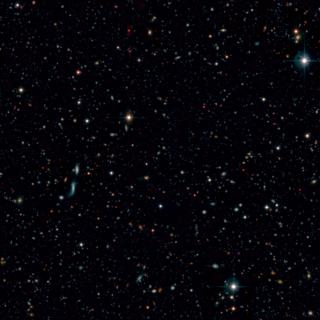Bibcode
Oteo, I.; Sobral, D.; Ivison, R. J.; Smail, I.; Best, P. N.; Cepa, J.; Pérez-García, A. M.
Referencia bibliográfica
Monthly Notices of the Royal Astronomical Society, Volume 452, Issue 2, p.2018-2033
Fecha de publicación:
9
2015
Número de citas
53
Número de citas referidas
50
Descripción
We present a detailed multiwavelength study (from rest-frame ultraviolet
to far-infrared) of narrow-band selected, star-forming (SF) Hα
emitters (HAEs) at z ˜ 2.23 taken from the High-Redshift(Z)
Emission Line Survey (HiZELS). We find that HAEs have similar properties
and colours derived from spectral energy distributions as sBzK galaxies,
and probe a well-defined portion of the SF population at z ˜ 2.
This is not true for Lyα emitters (LAEs), which are strongly
biased towards blue, less massive galaxies (missing a significant
percentage of the SF population). Combining our Hα observations
with matched, existing Lyα data, we determine that the Lyα
escape fraction (fesc) is low (only ˜4.5 per cent of
HAEs show Lyα emission) and decreases with increasing dust
attenuation, ultraviolet continuum slope, stellar mass and star
formation rate (SFR). This suggests that Lyα preferentially
escapes from blue galaxies with low dust attenuation. However, a small
population of red and massive LAEs is also present, in agreement with
previous works and indicating that dust and Lyα are not mutually
exclusive. Using different and completely independent measures of the
total SFR, we show that the Hα emission is an excellent tracer of
star formation at z ˜ 2 with deviations typically lower than 0.3
dex for individual galaxies. We find that the slope and zero-point of
the HAE main sequence at z ˜ 2 strongly depend on the
dust-correction method used to recover the SFR, although they are
consistent with previous works when similar assumptions are made.
Proyectos relacionados

Evolución de Galaxias
El estudio de la evolución de las galaxias es un tema crucial de la Astronomía Extragaláctica moderna. Permite vincular las galaxias locales con las primeras que existieron en el universo. Pero para poder abordarlo es preciso obtener censos estadísticamente significativos de galaxias de distintas luminosidades, a distintas distancias
Jorge
Cepa Nogue